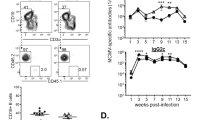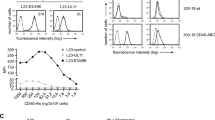Abstract
In this work, we have assessed the impact in vivo of the evasion gene A238L of African swine fever virus, an inhibitor of both NF-κB- and NFAT-mediated transcription. The A238L gene was selectively expressed in mouse B lymphocytes using the promoter and enhancer sequences of the mouse Ig μ heavy chain. The IgM primary and IgG2b secondary serological responses and the number of splenic germinal centres in response to the TD antigens DNP-keyhole limpet hemocyanin and sheep red blood cells, respectively, were both lower in the transgenic mice, whereas the response to the TI type-1 and type-2 antigens DNP-Ficoll and DNP-LPS, respectively, were normal, except for the increased levels of IgG3 at day 14 in the DNP-LPS-immunized mice. Thus, it appears that neither p65 (NF-κB) nor NFAT is essential for B-cell development but, in a manner that is still unclear, may be relevant for their function.




Similar content being viewed by others
References
Finlay BB, McFadden G (2006) Anti-immunology: evasion of the host immune system by bacterial and viral pathogens. Cell 124(4):767–782. doi:10.1016/j.cell.2006.01.034
Vischer HF, Vink C, Smit MJ (2006) A viral conspiracy: hijacking the chemokine system through virally encoded pirated chemokine receptors. Curr Top Microbiol Immunol 303:121–154
Loo YM, Gale M (2007) Viral regulation and evasion of the host response. Curr Top Microbiol Immunol 316:295–313
Unterholzner L, Bowie AG (2008) The interplay between viruses and innate immune signaling: recent insights and therapeutic opportunities. Biochem Pharmacol 75(3):589–602. doi:10.1016/j.bcp.2007.07.043
Bonjardim CA, Ferreira PCP, Kroon EG (2009) Interferons: signaling, antiviral and viral evasion. Immunol Lett 122(1):1–11. doi:10.1016/j.imlet.2008.11.002
Jonjić S, Babić M, Polić B, Krmpotić A (2008) Immune evasion of natural killer cells by viruses. Curr Opin Immunol 20(1):30–38. doi:10.1016/j.coi.2007.11.002
Revilla Y, Granja AG (2009) Viral mechanisms involved in the transcriptional CBP/p300 regulation of inflammatory and immune responses. Crit Rev Immunol 29(2):131–154. doi:10.1615/CritRevImmunol.v29.i2.30
Zhou F (2009) Molecular mechanisms of viral immune evasion proteins to inhibit MHC class I antigen processing and presentation. Int Rev Immunol 28(5):376–393. doi:10.1080/08830180903013034
Powell PP, Dixon LK, Parkhouse RM (1996) An IkappaB homolog encoded by African swine fever virus provides a novel mechanism for downregulation of proinflammatory cytokine responses in host macrophages. J Virol 70(12):8527–8533. Available at http://www.ncbi.nlm.nih.gov/pmc/articles/PMC190944/pdf/708527.pdf
Revilla Y, Callejo M, Rodríguez JM, Culebras E, Nogal ML, Salas ML et al (1998) Inhibition of nuclear factor kappaB activation by a virus-encoded IkappaB-like protein. J Biol Chem (Internet) 273(9):5405–5411. doi:10.1074/jbc.273.9.5405
Miskin JE, Abrams CC, Goatley LC, Dixon LK (1998) A viral mechanism for inhibition of the cellular phosphatase calcineurin (New York, NY). Science 281(5376):562–565. doi:10.1126/science.281.5376.562
Miskin JE, Abrams CC, Dixon LK (2000) African swine fever virus protein A238L interacts with the cellular phosphatase calcineurin via a binding domain similar to that of NFAT. J Virol 74:9412–9420. doi:10.1128/JVI.74.20.9412-9420.2000
Granja AG, Nogal ML, Hurtado C, Vila V, Carrascosa AL, Salas ML et al (2004) The viral protein A238L inhibits cyclooxygenase-2 expression through a nuclear factor of activated T cell-dependent transactivation pathway. J Biol Chem 279:53736–53746. doi:10.1074/jbc.M406620200
Granja AG, Nogal ML, Hurtado C, Del Aguila C, Carrascosa AL, Salas ML et al (2006) The viral protein A238L inhibits TNF-alpha expression through a CBP/p300 transcriptional coactivators pathway. J Immunol 176:451–462. doi:10.4049/jimmunol.176.1.451
Granja AG, Sabina P, Salas ML, Fresno M, Revilla Y (2006) Regulation of inducible nitric oxide synthase expression by viral A238L-mediated inhibition of p65/RelA acetylation and p300 transactivation. J Virol 80:10487–10496. doi:10.1128/JVI.00862-06
Granja AG, Perkins ND, Revilla Y (2008) A238L inhibits NF-ATc2, NF-kappa B, and c-Jun activation through a novel mechanism involving protein kinase C-theta-mediated up-regulation of the amino-terminal transactivation domain of p300. J Immunol 180:2429–2442. doi:10.4049/jimmunol.180.4.2429
Granja AG, Sánchez EG, Sabina P, Fresno M, Revilla Y (2009) African swine fever virus blocks the host cell antiviral inflammatory response through a direct inhibition of PKC-theta-mediated p300 transactivation. J Virol 83(2):969–980. doi:10.1128/JVI.01663-08
Gerritsen ME, Williams AJ, Neish AS, Moore S, Shi Y, Collins T (1997) CREB-binding protein/p300 are transcriptional coactivators of p65. Proc Natil Acad Sci USA 94(7):2927–2932. Available from http://www.pnas.org/content/94/7/2927.full.pdf+html
Perkins ND, Felzien LK, Betts JC, Leung K, Beach DH, Nabel GJ (1997) Regulation of NF-kappa B by cyclin-dependent kinases associated with the p300 coactivator. Science 275:523–527. doi:10.1126/science.275.5299.523
García-Rodríguez C, Rao A (1998) Nuclear factor of activated T cells (NFAT)-dependent transactivation regulated by the coactivators p300/CREB-binding protein (CBP). J Exp Med 187(12):2031–2036. http://www.ncbi.nlm.nih.gov/pmc/articles/PMC2212364/pdf/98-0100.pdf
Almeida SCP, de Oliveira VL, Ventura S, Bofill M, Parkhouse RME (2012) Neoplastic transformation of T lymphocytes through transgenic expression of a virus host modification protein. PloS One 7(4):e34140. doi:10.1371/journal.pone.0034140
Jung D, Giallourakis C, Mostoslavsky R, Alt FW (2006) Mechanism and control of V(D)J recombination at the immunoglobulin heavy chain locus. Annu Rev Immunol 24:541–570. doi:10.1146/annurev.immunol.23.021704.115830
Matsuda S, Shibasaki F, Takehana K, Mori H, Nishida E, Koyasu S (2000) Two distinct action mechanisms of immunophilin-ligand complexes for the blockade of T-cell activation. EMBO Rep 1(5):428–434. doi:10.1093/embo-reports/kvd090
Tait SW, Reid EB, Greaves DR, Wileman TE, Powell PP (2000) Mechanism of inactivation of NF-kappa B by a viral homologue of I kappa b alpha. Signal-induced release of i kappa b alpha results in binding of the viral homologue to NF-kappa B. J Biol Chem 275(44):34656–34664. doi:10.1074/jbc.M000320200
Gerondakis S, Grossmann M, Nakamura Y, Pohl T, Grumont R (1999) Genetic approaches in mice to understand Rel/NF-kappaB and IkappaB function: transgenics and knockouts. Oncogene 18(49):6888–6895. Available from http://www.nature.com/onc/journal/v18/n49/pdf/1203236a.pdf
Liou HC, Sha WC, Scott ML, Baltimore D (1994) Sequential induction of NF-kappa B/Rel family proteins during B-cell terminal differentiation. Mol Cell Biol 14(8):5349–5359. doi:10.1128/MCB.14.8.5349
Doi TS, Takahashi T, Taguchi O, Azuma T, Obata Y (1997) NF-kappa B RelA-deficient lymphocytes: normal development of T cells and B cells, impaired production of IgA and IgG1 and reduced proliferative responses. J Exp Med 185(5):953–961. doi:10.1084/jem.185.5.953
Alcamo E, Hacohen N, Schulte LC, Rennert PD, Hynes RO, Baltimore D (2002) Requirement for the NF-kappaB family member RelA in the development of secondary lymphoid organs. J Exp Med 195(2):233–244. doi:10.1084/jem.20011885
Sha WC, Liou HC, Tuomanen EI, Baltimore D (1995) Targeted disruption of the p50 subunit of NF-kappa B leads to multifocal defects in immune responses. Cell 80(2):321–330. doi:10.1016/0092-8674(95)90415-8
Snapper CM, Rosas FR, Zelazowski P, Moorman MA, Kehry MR, Bravo R et al (1996) B cells lacking RelB are defective in proliferative responses, but undergo normal B cell maturation to Ig secretion and Ig class switching. J Exp Med 184(4):1537–41. Available from http://jem.rupress.org/content/184/4/1537.long
Schwarz EM, Krimpenfort P, Berns A, Verma IM (1997) Immunological defects in mice with a targeted disruption in Bcl-3. Genes Dev 11(2):187–197. doi:10.1101/gad.11.2.187
Paxian S, Merkle H, Riemann M, Wilda M, Adler G, Hameister H et al (2002) Abnormal organogenesis of Peyer’s patches in mice deficient for NF-kappaB1, NF-kappaB2, and Bcl-3. Gastroenterology 122(7):1853–1868. doi:10.1053/gast.2002.33651
Crabtree GR, Olson EN (2002) NFAT signaling: choreographing the social lives of cells. Cell 109(Suppl):S67–S79. doi:10.1016/S0092-8674(02)00699-2
Hogan PG, Chen L, Nardone J, Rao A (2003) Transcriptional regulation by calcium, calcineurin, and NFAT. Genes Dev 17(18):2205–2232. doi:10.1101/gad.1102703
Serfling E, Berberich-Siebelt F, Avots A, Chuvpilo S, Klein-Hessling S, Jha MK et al (2004) NFAT and NF-kappaB factors-the distant relatives. Int J Biochem Cell Biol 36(7):1166–1170. doi:10.1016/j.biocel.2003.07.002
Brabletz T, Pietrowski I, Serfling E (1991) The immunosuppressives FK 506 and cyclosporin A inhibit the generation of protein factors binding to the two purine boxes of the interleukin 2 enhancer. Nucleic Acids Res 19(1):61–67. doi:10.1093/nar/19.1.61
Berland R, Wortis HH (1998) An NFAT-dependent enhancer is necessary for anti-IgM-mediated induction of murine CD5 expression in primary splenic B cells. J Immunol 161(1):277–285. Available from http://www.jimmunol.org/content/161/1/277.long
Hodge MR, Ranger AM, Charles de la Brousse F, Hoey T, Grusby MJ, Glimcher LH (1996) Hyperproliferation and dysregulation of IL-4 expression in NF-ATp-deficient mice. Immunity 4(4):397–405. doi:10.1016/S1074-7613(00)80253-8
Berland R, Wortis HH (2003) Normal B-1a cell development requires B cell-intrinsic NFATc1 activity. Proc Natl Acad Sci USA 100(23):13459–13464. doi:10.1073/pnas.2233620100
Samanta DN, Palmetshofer A, Marinkovic D, Wirth T, Serfling E, Nitschke L (2005) B cell hyperresponsiveness and expansion of mature follicular B cells but not of marginal zone B cells in NFATc2/c3 double-deficient mice. J Immunol 174(8):4797–4802. doi:10.4049/jimmunol.174.8.4797
Ranger AM, Hodge MR, Gravallese EM, Oukka M, Davidson L, Alt FW et al (1998) Delayed lymphoid repopulation with defects in IL-4-driven responses produced by inactivation of NF-ATc. Immunity 8(1):125–134. doi:10.1016/S1074-7613(00)80465-3
Peng SL, Gerth AJ, Ranger AM, Glimcher LH (2001) NFATc1 and NFATc2 together control both T and B cell activation and differentiation. Immunity 14(1):13–20. doi:10.1016/S1074-7613(01)00085-1
Winslow MM, Gallo EM, Neilson JR, Crabtree GR (2006) The calcineurin phosphatase complex modulates immunogenic B cell responses. Immunity 24(2):141–152. doi:10.1016/j.immuni.2005.12.013
Xanthoudakis S, Viola JP, Shaw KT, Luo C, Wallace JD, Bozza PT et al (1996) An enhanced immune response in mice lacking the transcription factor NFAT1. Science 272(5263):892–895. doi:10.1126/science.272.5263.892
Kiani A, Viola JP, Lichtman AH, Rao A (1997) Down-regulation of IL-4 gene transcription and control of Th2 cell differentiation by a mechanism involving NFAT1. Immunity 7(6):849–860. doi:10.1016/S1074-7613(00)80403-3
Schuh K, Kneitz B, Heyer J, Bommhardt U, Jankevics E, Berberich-Siebelt F et al (1998) Retarded thymic involution and massive germinal center formation in NF-ATp-deficient mice. Eur J Immunol 28(8):2456–2466. doi:10.1002/(SICI)1521-4141(199808)28:08<2456:AID-IMMU2456>3.0.CO;2-9
Yoshida H, Nishina H, Takimoto H, Marengère LE, Wakeham AC, Bouchard D et al (1998) The transcription factor NF-ATc1 regulates lymphocyte proliferation and Th2 cytokine production. Immunity 8(1):115–124. doi:10.1016/S1074-7613(00)80464-1
Acknowledgments
We acknowledge Moises Mallo for the production of the transgenic mice. We acknowledge Dr. Pedro Simas for providing us the pµs plasmid. SCP Almeida designed and performed the experiments, generated the transgenic mice colony, and wrote and revised the manuscript. VLO performed the experiments and revised the manuscript. RME Parkhouse designed the project and wrote and revised the manuscript. This work was supported by Fundação para a Ciência e Tecnologia, Ministério da Ciência e Ensino Superior (SFRH/BD/882/2000; POCTI/2000/MGI/36403) and by the Wellcome Trust (WT075813MA).
Conflict of interest
There are no conflicting interests. The funders had no role in study design, data collection and analysis, decision to publish or preparation of the manuscript.
Author information
Authors and Affiliations
Corresponding author
Additional information
S. C. P. Almeida and V. L. de Oliveira contributed equally to this work.
Rights and permissions
About this article
Cite this article
de Paiva e Almeida, S.C., de Oliveira, V.L. & Parkhouse, R.M.E. Impact on antibody responses of B-cell-restricted transgenic expression of a viral gene inhibiting activation of NF-κB and NFAT. Arch Virol 160, 1477–1488 (2015). https://doi.org/10.1007/s00705-015-2419-x
Received:
Accepted:
Published:
Issue Date:
DOI: https://doi.org/10.1007/s00705-015-2419-x




